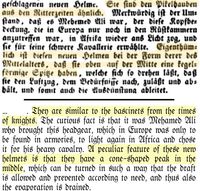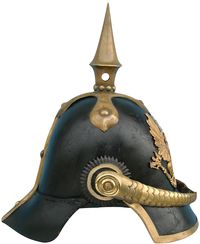About the origin of the German nickname "Pickelhaube" and the English name „spiked helmet“
The nickname "Pickelhaube" was coined by military journalists. This happened as early as 1841, when they first saw the helmet, which was still being tested at that time. Thus, the "Allgemeine Militär-Zeitung" No. 63 of 1841 wrote: "They are very similar to the „Pickelhauben“ from the knightly era....A peculiar feature of these new helmets, with their medieval shape, that they have a conical tip in the middle at the top...".
The Landsknechts experienced they greatest importance under Emperor Maximilian I (March 22, 1459 to January 12, 1519), also known as the last knight, as he ended the age of the knights with their help. The Landsknechts were more numerous, cheaper and not as highly specialized as the elite fighters. On the battlefield, they were superior to knights because of their sheer mass.
But it doesn't matter whether it's "Beckenhaube", "Bickelhûbe", "Pechelhaube", "Peckelhuebchen", "Begelhube" or even "Pickelhaube", all of these names are a dialect of one and the same term. And even if the name, as just showed, does not actually refer to the tip of the helmet, I think that it quickly became established in German-speaking countries precisely because of the tip and the witty ambiguity of the name.
In English, the Pickelhaube became known as the "spiked helmet", which sometimes, as I learned through my international collector friends, led to some confusion in translation. This is because if the term "spiked helmet" is translated literally, the English name would be "pimple hood" or "pimple hat". However, I could not find such a term in English texts of the 19th century. The term "spike", on the other hand, I could verify in relation to the Prussian helmet already in a text from 18441, and the entire term "spiked helmet" in a text from 1849.2 However, it was partly assumed in my English-speaking contacts that the word part "spike" is a translation of the word part "pickel" and also the German term, just like it is the case in English, refers to the tip of the helmet.
- A hot-water cure, sought out in Germany, in the summer of 1844, the journal of a patient - Page 133
- Blackwood's Magazine, Volume 66 (July-December 1849) - Page 427


